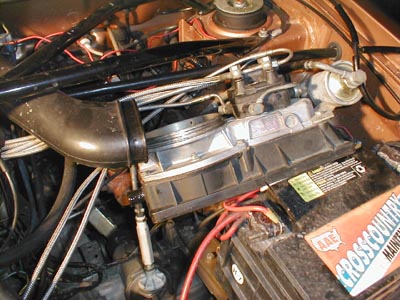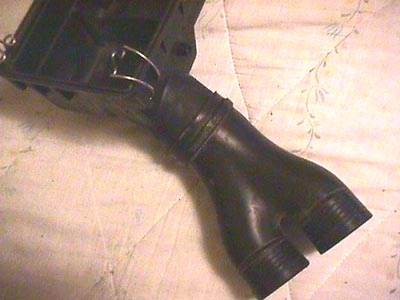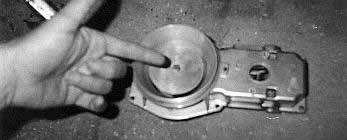| The first thing to tackle
here, will be the air box area of induction. The airbox consists of the
filter housing (the "box" itself), the filter element, the air flow meter
and fuel distributor.
Table of Contents:
REMOVING INTAKE AIR HEATER: There is a rather impressive restriction in the air inlet neck of the airbox, where a flap resides that directs air from either outside or air heated by the exhaust manifold. I have "chosen" to do without the heated intake air and have removed the "pipe" from the exhaust manifold to the air box inlet. These are removed my simply unscrewing the hose clamps on either end of the "pipe". Removal of other components is not necessary to accomplish this. The neck with the restriction (the flap controller) can now be removed using a stubby phillips head screwdriver. Make sure to undo the hose clamp that attaches the cold air intake hose to the neck. Discard the neck and reapply the cold air intake hose to the air box. This will require a new longer hose to reattach the inlet on the airbox to the front of the car. You can buy MotorMite heater hose that fits at nearly any auto parts store. Don't make the hose too curvy or long as this will defeat the purpose. You could also do without the hose altogether. At higher speeds where the air is most needed, the air flow around the air box is enough to allow only fresh air in through the snorkel. DRILLING HOLES IN THE AIR BOX (HOUSING): What's the point? One would assume that doing this allows more air flow. There are truly bigger fish to fry. The air filter, flow plate, the flow tube, the throttle, the intake manifold....all have their own restrictions. Removing the intake air heater will open up a clear 1 1/2" hole for COLD air to get in via the cold air intake tube. One argument against the action is that the drilling of holes in the airbox will mix the cold air from the intake hose with hot air from the engine compartment (since drilled holes are non-directional), which would neither be advantageous nor disadvantageous at anything above parking lot speeds. I personally feel that the stock, or even near stock, Rabbit does not require THIS MUCH air flow, but it does add a neat low note bellowing from under your hood. ;-) HOW ABOUT A LARGER AIR BOX INLET?: Good ol' BFDeihl pointed out to me that a Scirocco 16V has a larger cold air inlet on it's air box then a typical 8V! Furthermore, the dual intake tubes off of an Audi 5000 fits perfectly over that inlet offering a great "ram air" effect. To remove the lower half of the air box is easy. Just disconnect all of the intake tubes (the crank case vent, flow plate boot, intake tube, etc.) and unclip the box as if you are changing an air filter. You should be able to unclip the lower half and slide it out past the clutch cable (tight fit). Now of course, this isn't the EASIEST way. The easiest way is to disconnect the two fuel line going to and from the tank and to move the upper air box/fuel distributor assembly away from this side of the engine and then lift the lower half straight up and out.
You can see here the big difference in size between the stock 8V intake and the 16V one.
Unfortunately, I can't find the Audi snorkel I got from the junkyard, but BFDeihl did send me a picture of the snorkel installed in the airbox. There are also corrugated hoses that come with this snorkel that are perfect for setting it a modified air dam. They are not shown in the picture, but it would be on the same car as the snorkel.
THE AIR FILTER: Just got off the phone with Tom at Total Performance and got him to set me aside a K&N Filter for $45. Aside from the claims of significantly increased horsepower, which I am still skeptical about, the K&N filter DOES increase flow through the air box. What about that hefty price tag? Well, considering one K&N filter needs to be cleaned and reoiled ONCE for every three paper element filters (50,000 miles of normal use), I'd say, "in the long run it will pay for itself". THE FLOW PLATE: A larger flow plate may increase horsepower, I'm not going to say it does. Neuspeed says that "their" throttle body (even with it's cheesy adapter plate) increases horsepower, but I've yet to talk to someone that has truly "noticed", or documented for that matter, the gain. What people DO notice when they change their throttle and/or flow plate, is throttle response. The car is propelled to it's power range quicker, thus getting your engine to the place it wants to be to produce power. Therefore, these mods are a good thing for most people. I say "most people" because the larger flow plate tends to lean out the mixture at higher throttle positions. You see, more air is traveling through the airbox while the same amount of fuel is being metered out as before (I proved this to myself by hooking a dwell meter to the test port on the fire wall). It's a very slight difference, but it may make or break you in Turbo applications. The flow plate is the round metal plate located above the air filter on the end of a see-saw type mechanism (see saw can not be seen from top. It's hidden underneath). The principle here is that engine vacuum sucks the plate up thus opening orifices in the fuel distributor, delivering a properly metered amount of fuel to the injectors. These flow plates come in three sizes, and if your car is pre '83, you could use a bigger one. These flow plates are readily available in the junkyard. Removing only the fuel distributor from the airbox top is required, although some people have suggested in the NGs that the use of a Porsche 924 fuel distributor as well as the flow plate can be beneficial, I have no personal experience with doing this. First, the car should be cold. Not temperature cold, but not been started in a while cold. Remember, you CIS maintains a very high fuel pressure, even off, and you want the fuel pressure in the lines to have died down a bit. Next, release, but not remove, all of the fuel fittings at the fuel distributor. You will want to undo the clamp around the fuel filter as well. Now you can access the three flat head screw that hold the fuel distributor to the top of the air box. Loosen these three screws completely and the distributor and filter should pull off to the side (toward the firewall). With a 10MM socket or nut driver, remove all six screws holding the air flow plate assembly to the airbox top (or remove the airbox top completely and remove the flow plate away from the car) and swap out the assembly. Place the fuel distributor back into place. If you find the center plunger (the stainless steel piece of metal that protrudes from the distributor and into the flow plate assembly) is stuck in the closed position (all of the way out), GENTLY push the clip that keeps the plunger from popping out altogether (please have something GENTLE, like a hand, under it to catch it!!) and the spring and residual fuel pressure will push it out the rest of the way. Clean this piece up real nice and reinsert. This time it should go all of the way in with no restriction. Bend the clip back into the plunger the way you found it and reassemble.
It will likely be necessary to have to readjust the air/fuel (3mm screw), since the flow meter is now in a different car, mounted on a different airbox, etc. WHILE YOU'RE AT IT: I have a friend that needs
more fuel for his turbo Rabbit pickup. He shimmed the fuel distributor
and added a new LARGER Golf fuel filter. I asked "how restrictive is the
fuel filter???" The lines going in and out of them are still the same.
Well, another friend that is a mechanic at a VW shop, without asking, suggested
I grab the clamp off of a "new" Golf and install it with a larger late
model fuel filter next time I do a filter change. I don't have proof that
this helps, but MORE fuel and MORE air always helps no matter how you get
the job done. Therefore, I give this advice a "why not". The clamp is pretty
much a gimme at the U-Pull yard and you change your filter regularly anyway,
so you might as well use the large filter, right?
|



